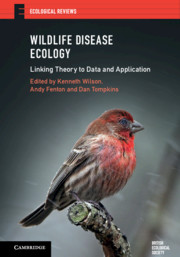Book contents
- Wildlife Disease Ecology
- Ecological Reviews
- Wildlife Disease Ecology
- Copyright page
- Contents
- Contributors
- Preface: Wildlife Disease Ecology
- Glossary of Terms
- Part I Understanding within-host processes
- Part II Understanding between-host processes
- Chapter Eight Using insect baculoviruses to understand how population structure affects disease spread
- Chapter Nine Infection and invasion: study cases from aquatic communities
- Chapter Ten Parasite-mediated selection in red grouse – consequences for population dynamics and mate choice
- Chapter Eleven Emergence, transmission and evolution of an uncommon enemy: Tasmanian devil facial tumour disease
- Chapter Twelve Bovine tuberculosis in badgers: sociality, infection and demography in a social mammal
- Chapter Thirteen Mycoplasma ovipneumoniae in bighorn sheep: from exploration to action
- Chapter Fourteen Manipulating parasites in an Arctic herbivore: gastrointestinal nematodes and the population regulation of Svalbard reindeer
- Part III Understanding wildlife disease ecology at the community and landscape level
- Index
- Plate Section (PDF Only)
- References
Chapter Nine - Infection and invasion: study cases from aquatic communities
from Part II - Understanding between-host processes
Published online by Cambridge University Press: 28 October 2019
- Wildlife Disease Ecology
- Ecological Reviews
- Wildlife Disease Ecology
- Copyright page
- Contents
- Contributors
- Preface: Wildlife Disease Ecology
- Glossary of Terms
- Part I Understanding within-host processes
- Part II Understanding between-host processes
- Chapter Eight Using insect baculoviruses to understand how population structure affects disease spread
- Chapter Nine Infection and invasion: study cases from aquatic communities
- Chapter Ten Parasite-mediated selection in red grouse – consequences for population dynamics and mate choice
- Chapter Eleven Emergence, transmission and evolution of an uncommon enemy: Tasmanian devil facial tumour disease
- Chapter Twelve Bovine tuberculosis in badgers: sociality, infection and demography in a social mammal
- Chapter Thirteen Mycoplasma ovipneumoniae in bighorn sheep: from exploration to action
- Chapter Fourteen Manipulating parasites in an Arctic herbivore: gastrointestinal nematodes and the population regulation of Svalbard reindeer
- Part III Understanding wildlife disease ecology at the community and landscape level
- Index
- Plate Section (PDF Only)
- References
Summary
Invasive species drive biodiversity loss and lead to changes in parasite–host associations. Parasites are linked to invasions and can mediate invasion success and outcomes. We review theoretical and empirical research into parasites in biological invasions, focusing on a freshwater invertebrate study system. We focus on the effects of parasitic infection on host traits (behaviour and life history) that can mediate native/invader trophic interactions. We review evidence from the field and laboratory of parasite-driven changes in predation, intraguild predation and cannibalism. Theoretical work shows that the trait-mediated effects of parasites can be as strong as classical density effects and their impact on the host’s trophic interactions merits more consideration. We also report on evidence of broader cascading effects warranting deeper study. Biological invasion can lead to altered parasite–host associations. Focusing on amphipod invasions, we find patterns of parasite introduction and loss that mirror host invasion pathways, but also highlight the risks of introducing invasive parasites. Horizon scanning and impact predictions are vital in identifying future disease risks, potential pathways of introduction and suitable management measures for mitigation.
Keywords
- Type
- Chapter
- Information
- Wildlife Disease EcologyLinking Theory to Data and Application, pp. 262 - 295Publisher: Cambridge University PressPrint publication year: 2019
References
- 4
- Cited by



